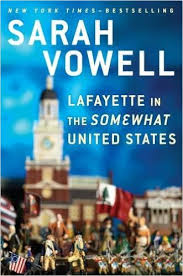Lafayette in the Somewhat United States
- By Sarah Vowell
- Riverhead Books
- 288 pp.
- Reviewed by Adele Levine
- November 6, 2015
A cartoonish romp through Revolutionary War-era America with an avenging aristocrat.

Historical comedy fans will be entertained by Sarah Vowell’s latest book, Lafayette in the Somewhat United States, as she paints a complicated sitcom about the Revolutionary War straight from the “patriot blooper reel.”
Vowell’s writing is conversational, accentuated by its unusual layout: a single, long essay without chapters. The storyline organizes itself loosely around Lafayette — “France’s richest orphan” — who sailed to America on his own ship to fight the British for adventure and revenge.
That alone would make for an interesting book, but Vowell has also done enviable research, populating it with numerous facts, anecdotes, and characters. Many of these are colorful, though some have a tangential feel.
While I laughed frequently at her cheeky, breezy writing style, it became fatiguing to keep track of so many details. I was constantly doubling back and rereading sections to stay with the story. Without numeric breaks to organize the book for me, I constantly forgot where we were in the conversation.
If you happen to be a Revolutionary War expert, this won’t be a problem. But if you failed history because you only showed up for the final exam — and have a recurring nightmare that the test is the next day and you haven’t bought the text yet — this book might bring on some anxiety. I read it with a highlighter in hand.
Vowell herself describes her disjointed writing manner halfway through the book: “Having studied art history, as opposed to political history I tend to incorporate found objects into my books…I like to use whatever’s lying around to paint pictures of the past — traditional pigments like archival documents but also the added texture of whatever bits and bobs I learn from looking out bus windows or chatting up the people I bump into on the road.”
Vowell starts the book off at its ending — when an aged Lafayette returns to the United States 41 years after the end of the Revolutionary War for a sentimental victory lap. Almost three-quarters of the population of NYC turned out to greet him. I kept hoping to experience the sentiment that inspired such a huge crowd, but the Lafayette in the book, made of little “bits and bobs,” failed to materialize into a truly inspiring character.
As a nod perhaps to Vowell’s art-history background, the book is punctuated by cartoon headshots of 15 of the characters — including King Louis XVI with his head cut off. But typical to the book, the cartoons themselves do not always sync with the current storyline.
I did, however, appreciate the depth Vowell brought to the Revolutionary War. Between the cross-dressing French spy and the gunrunning French playwright, had she been my history professor, I wouldn’t have missed a single class. But, in her book, I needed a little less banter and a little more character development.
Vowell laments how little Americans know about the Revolution. “Sixty percent of those surveyed correctly identified the number of children parented by reality TV personalities Jon and Kate Gosselin, but over a third did not know the century in which the American Revolution took place.”
I firmly fit in both camps and read this book hoping to expand my knowledge of American history. Yet, this was really more of a niche volume, as I felt that Vowell was less interested in educating and more interested in examining the many different narratives running under the current of the war. While thought-provoking, it was easy to get overwhelmed by the breadth of the content.
Just as Southern novelist William Faulkner made a statement when he wrote sentences that went on for pages, perhaps Vowell was also trying to do something artistic with a book that spirals off into millions of galaxies. Or maybe she got caught up in writing a thesis.
Adele Levine is author of Run, Don't Walk: The Curious and Courageous Life Inside Walter Reed Army Medical Center.

